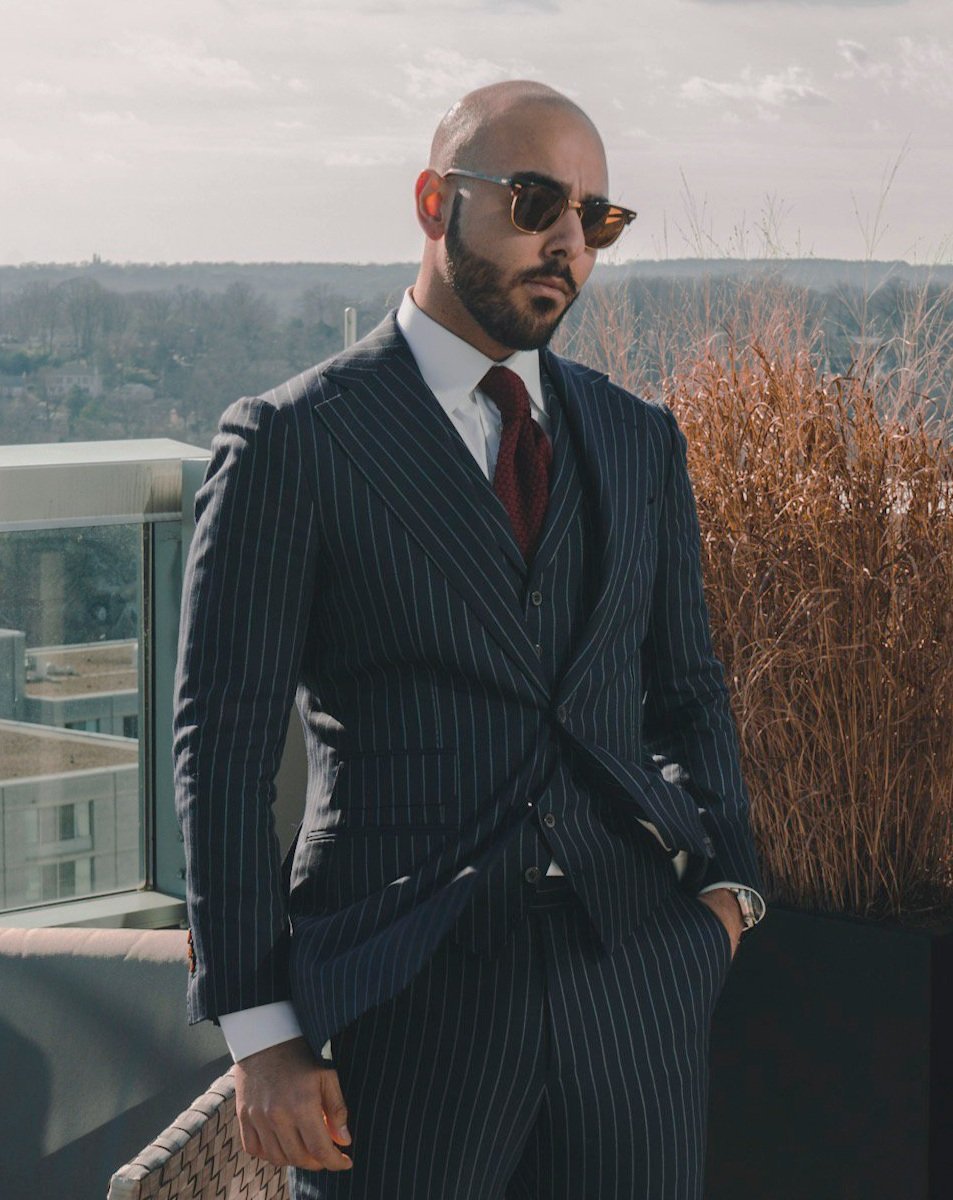2025 Suit Trends for Men - From a DC Custom Clothier
The world of men’s fashion is always changing and 2025 is a year that should see bold decisions and new takes on classic tailoring really starting to come to the fore. After the resurgence of wider lapels in 2024, we’re seeing the continuation of this trend, alongside a revival of vintage inspired looks, a growing emphasis on sustainability, and a shift towards individuality in men’s formalwear. This year, suits are not just about looking sharp — they’re about making a statement. Let’s take a closer look at the key trends shaping men’s suit styles for 2025.
Wide Lapels: The Continuing Revival
Wide lapels were one of the most popular trends in 2024 and are still going strong in 2025. The traditional and bold look that wide lapels give is still very much in sight on the runways and fashionistas, paying homage to the sharp suits of the mid-20th century. These lapels are dramatic, and they are a sign of confidence and class. They make the shoulders and chest wider and give off that cocky vibe of, “I know I’m bad.” Wide lapels will be taken to the extreme in 2025, from the extremely exaggerated versions in high-fashion collections to more subtle but still noticeable changes in custom suit offerings. The versatility of wide lapels is what makes them so appealing. They can be worn with traditional tailoring, or with more casual, even deconstructed styles, allowing men to add a touch of sophistication to their look without going overboard. Whether it is a double-breasted custom suit or a single-breasted sport coat, wide lapels are here to stay as one of the defining elements of modern masculinity.
Why Slim Lapels Are Out
Slim lapels have been prevalent in menswear for most of the past two decades due to the development of fast fashion and the shift of the industry toward mass production. At the turn of the century, fast fashion retailers, looking to cash in on the trend oriented cycle, adopted a simplified, minimalist approach to clothing. Slim lapels were promoted as being sleek, modern and versatile, in line with the more general cultural trend towards the ‘everything slim’ – from skinny jeans to form-fitted shirts. These retailers understood the appeal of slimness and marketed it as the style ideal that could be easily adopted by everyone, something that could be easily reproduced in large quantities at low cost. Fast fashion delivered slim lapels as cheaper, often less durable products that were made to wear and dispose of, rather than to keep and cherish.
The marketing strategy also stressed the ‘universal’ nature of the slim fit, claiming that it was a look that could suit anyone and everyone. This made it easier for brands to promote one style of product that could be produced quickly and sold to a wide audience without the need to identify and address the tastes and needs of a diverse global customer base. The result of this was an overwhelming visual culture of narrowly cut suits with sharply tailored, often tight-fitting lapels that were deemed to embody ‘modern masculinity’ for much of the early 21st century. Initially viewed as a trendy, youthful alternative to the boxier, more conventional suits of the 1980s and 1990s, it did not possess the rich, versatile possibilities of a more diverse range of cuts and styles.
Vintage-Inspired Looks
Menswear has seen a steady resurgence of vintage and vintage-inspired clothing over the past few years and will only continue to do so in 2025. The 1970s bold checks and plaids, the cut suits of the 1930s or the relaxed easy style of the 1960s. Contemporary suits are being designed to incorporate elements of vintage charm and some of these are made with today’s fabrics or in a more relaxed fit to cater to the gen z trend of bringing back bagginess. This trend is quite extensive – from classic fits with more retro patterns to traditional fabrics with super loose silhouettes. It’s important to know your body type and what you want to achieve before trying to pull this trend off for yourself. I’ve only really noticed one real difference in suits, specifically workplace style, this year and that’s a more relaxed pant leg. Not tapered to fit, straight leg and pleats/cuffs.
In general, more iconic figures from past decades will be seen, such as Cary Grant's sharply tailored suits or Steve McQueen's laid back dapper. Nostalgia and innovation will be the key to 2025's vintage inspired suits, embracing retro details like peak lapels, high waisted trousers and strong shoulder lines.
Do’s and Don’ts of Vintage
When it comes to outfit ideas that are vintage-inspired for men, it should be said that the approach is best gradual, not aggressive. You should definitely use traditional elements like suits, large lapels, or high waist trousers that have connections with the past but you should also try to make them more contemporary or use alternative materials to not look like you are in a costume. Do not use too many vintage accessories or full retro outfits from head to toe – it is very easy to become a parody. Instead, try to include a few pieces like a leather jacket or a patterned tie into a more everyday wardrobe. Do mix vintage with the modern basics and do not forget to alter the length of the garment; a big jacket or baggy trousers may look authentic, but the fit is always a key to the stylish outcome.
Sustainability: Organic, Natural Materials Or Bust
As the fashion industry faces many environmental challenges, sustainability has become an important focus for designers and consumers. In 2025, the use and promotion of organic and natural materials in suit production will continue to increase. You will see suits made of sustainable wool, organic cotton, even bamboo, all of which are more environmentally friendly than traditional synthetics. If you have read Capitol Hill Clothiers Style Guides before, you might have a good idea that I have loathed synthetic materials for the entire existence of this brand. If you haven’t, here are a few posts that I suggest.
Should I Avoid Polyester in My Suits?
The Real Reason You’re Getting “Shocked” All Winter: Synthetic Fabrics
Dressing for Value: The Cost-Per-Wear Approach to Your Wardrobe
Fabric Abbreviations: Explained
Anyway, the movement towards sustainability isn’t just about materials but also about the way suits are crafted. Many consumers are embracing slow fashion, focusing on craftsmanship and quality that stands the test of time. A well-made, sustainable suit should be viewed not as a seasonal trend, but as a lasting investment — one that looks good, feels great, and reduces environmental impact. This shift also aligns with the growing consumer desire for transparency and ethical production practices.
An Unjust Burden Turned Into a Principle Motivator
The task of tackling the global challenges such as climate change, resource depletion, and waste has been placed on the consumers unnecessarily. ”It’s your fault the turtles are dying, stop using plastic straws”. It is great to have the power to make the right decisions but the responsibility of fixing the world should not be on the consumers. The fact remains that the change needs to be more systemic in nature, in the way that products are created, promoted, and used by companies, governments and industries. But, consumers are made to believe that their purchasing power can bring about change in the practices of big corporations and economic systems.
There’s a lot of rhetoric out there. It’s worth shopping sustainably for no other reason than that it’s a better quality investment for you.
Breaking from the Norm: It’s YOUR Suit
In 2025, men’s fashion is likely to push the envelope on individuality especially with regards to suits. In recent years, business attire has lost its stiffness and has turned from a boring, colorless uniform into a dress code that allows for some personality to shine through. This year, men are already experimenting with fashion and are not afraid to show it by wearing suits that suit their more whimsical and fun side. They will make use of playful patterns, surprising colors, and unique cuts.
If it’s a suit, men are encouraged to have fun with the shirt and tie. Wearing a bright blazer with a pair of tailored trousers or a rich textured fabric like hopsack or corduroy will give the suit more character and deviate from the conventional business look. Regarding the cut, some trends that have been ongoing for the past decades, such as the very tight and stiff fits, are leaving the scene.
Looser trousers, boxier jackets, and unlined blazers that have dominated the market in recent years are being replaced by a more casual and less restrictive approach to suiting. This is a move away from the stiff, formal attire of the past and a return to a more authentic, expressive form of dressing. The rise of custom tailoring and bespoke options is also empowering men to experiment with their wardrobe in a way that reflects their personality and tastes.
Business Attire Contexts
This trend is quite evident and can be quite tempting to emulate. But, it is important to consider the context in which you are working. Of course, a business casual startup will have no problem with how much you want to show your individuality in your 2025 wardrobe, but a law office, a bank, etc. will not. Some conventional workplace cultures continue to enforce strict dress codes that prioritize workplace decorum over employees’ freedom to express themselves, especially with regards to color, pattern, or fit. It’s brilliant to stand out in the right way, but in an environment where conformity to set rules is the norm, a more unconventional outfit can sometimes be considered too much or even inappropriate. Think about your clients too. They may not want their banker or lawyer to look too bold and fashion-forward.
A practical way of incorporating personalization into the workplace without compromising the office dress code is to start with the details. You can think about adding some small touches that reflect your style without forsaking the traditional dress code. A patterned tie, a charming pocket square, or cufflinks that hold a special meaning can be an excellent way to show individuality within the constraints of conventional fashion. It is also possible to try color – instead of traditional navy or charcoal gray suit, a rich burgundy or deep emerald green suit can add some interest without ignoring professionalism.
When working in a very strict setting, it might be best not to wear brightly colored and attention-seeking accessories like neon colors, but moderate colors that can help you stand out may also work well. In most cases, businesses that have a business-casual or casual culture in the workplace can allow employees to incorporate a bit of play into their work attires. Try it with texture – a tweed jacket with chinos, or a shirt with a subtle check or stripe. A sleek, properly tailored blazer with a somewhat relaxed fit for a more contemporary look but still within the context of a suit structure. In a sense, style in the workplace does not mean discarding the dress code – it means finding how to bring your style into an outfit that is appropriate for work.
A Relaxed Approach to Business Attire
2025 marks the continuation of the shift away from rigid, corporate dress codes. The pandemic sparked a global rethink of what professional attire should look like, and now we’re seeing a more relaxed, adaptable approach to businesswear. While formal office settings may still require a suit, the definition of “business casual” is rapidly expanding.
Slimmer, softer tailoring will dominate the office scene, with a focus on breathable, comfortable fabrics and versatile styles that can easily transition from the boardroom to after-hours drinks. Suits with relaxed fits, shorter jacket lengths, and lighter fabrics — perfect for year-round wear — will replace the heavy, traditional three-piece suits of the past. This flexibility allows men to infuse more personal style into their professional attire without sacrificing sophistication or polish.
Men’s suits in 2025 will be defined by versatility, sustainability, and individuality. Wide lapels remain a prominent feature, building on their popularity in 2024, while vintage-inspired designs continue to bring a nostalgic touch to modern tailoring. Sustainability is becoming more than a buzzword, with organic materials and eco-friendly practices taking center stage. And, perhaps most exciting of all, the rise of individuality is allowing men to break free from the constraints of traditional business attire, embracing fun patterns, creative silhouettes, and personalized details.
This year, men’s suits won’t just be a uniform for formal occasions — they’ll be a canvas for personal expression. Whether you’re going for a bold vintage look or choosing an eco-friendly, tailored masterpiece that makes a statement, the future of suiting is all about finding a balance between tradition and innovation. So go ahead — embrace the new era of suiting and wear your style with confidence in 2025.
Must-Have Custom Suits for 2025
Investing in a custom suit this year can elevate your wardrobe to new heights. A must-have is a single-breasted suit in a versatile earth tone, crafted from an eco-friendly fabric that stays true to the sustainability trend. Consider a suit with a detachable hood or adjustable hems, incorporating technological innovations for added functionality. Another essential is the double-breasted suit in a bold color like burgundy, designed with a modern cut that offers both comfort and style. Pair it with a statement shirt or tie to showcase your personality.
2025 is a year where tradition meets innovation in men's suiting. Emphasizing sustainability, technology, and personalization, these trends offer something for every style and occasion. Embrace these sartorial innovations and let your attire reflect the cutting-edge trends of the year.






